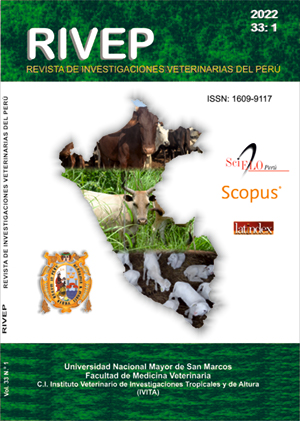Hormonal induction of flounder Paralichthys adspersus (Steindachner, 1867) and spawning quality by laboratory conditions
DOI:
https://doi.org/10.15381/rivep.v33i1.22157Keywords:
Paralichthys adspersus, spawning, hormonal induction, broodstock, GnRHAbstract
The aim of this objective study was to induce the spawning of mature females of Paralichthys asdpersus (sole) using a hormone analogue to gonadotropin (GnRHa) and to determine the quality of eggs and larvae obtained in the periods of 2014 and 2015. Females with oocytes were selected in advanced maturation (542.61 µm), which spawned after a latency period of 45-48 h at a temperature of 16.46 ± 0.06 °C. The percentage of fertilization was greater than 70% in both periods. The fertilized eggs had a diameter of 857.98 ± 5.90 µm and the oily droplet of 168.76 ± 5.31 µm. Hatching occurred 48 hours after spawning at 18.03 ± 0.13 °C, with percentages between 16.7 and 94.0% for both periods. For larval quality, the Larval Survival Index (ISL) was determined, where the larvae survived starvation for up to 11 days. The highest ISL value was 31.2% in 2014 and 22.9% in 2015. The accumulated mortality at day 3 (MA3) was higher in December 2014 (21.1%) and in April 2015 (13.7%). The proximal composition of eggs was 47.1% protein, 17.4% lipids and 3.9% carbohydrates. Fatty acids (mg/g of dry sample) show a predominance of polyunsaturated fatty acids, followed by saturated and monounsaturated fatty acids. DHA (docosahexaenoic acid, 22: 6n-3) was the most abundant of the polyunsaturated, followed by EPA (eicosapentaenoic acid, 20: 5n-3) and ARA (arachidonic acid 20: 4n-6). The DHA: EPA ratio was 3.4 ± 0.5. It is concluded that hormonal induction with GnRHa can produce quality eggs and larvae, however, it is necessary to consider a species specific diet for brodstock that can ensure good quality of the progeny.
Downloads
Downloads
Published
Issue
Section
License
Copyright (c) 2022 Lili Carrera, Noemí Cota, Joel Linares, Angélica Castro, Melissa Montes, Leenin Flores

This work is licensed under a Creative Commons Attribution 4.0 International License.
AUTHORS RETAIN THEIR RIGHTS:
a. Authors retain their trade mark rights and patent, and also on any process or procedure described in the article.
b. Authors retain their right to share, copy, distribute, perform and publicly communicate their article (eg, to place their article in an institutional repository or publish it in a book), with an acknowledgment of its initial publication in the Revista de Investigaciones Veterinarias del Perú (RIVEP).
c. Authors retain theirs right to make a subsequent publication of their work, to use the article or any part thereof (eg a compilation of his papers, lecture notes, thesis, or a book), always indicating the source of publication (the originator of the work, journal, volume, number and date).










